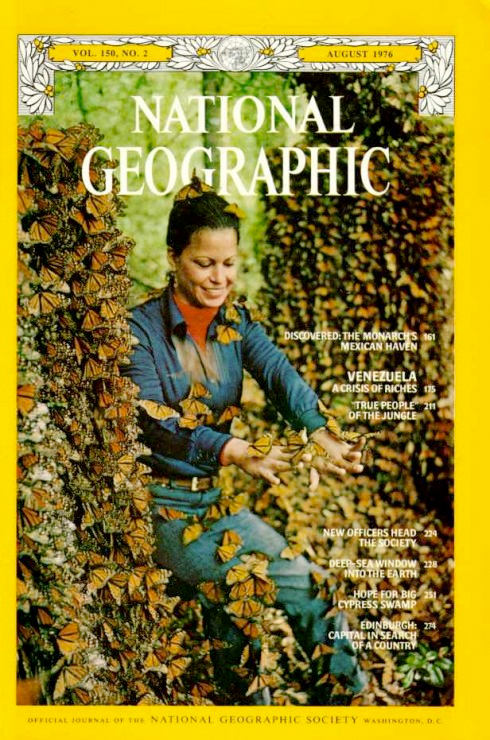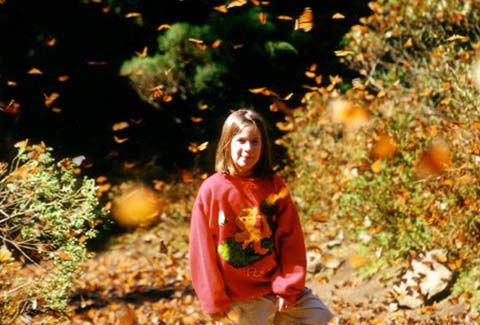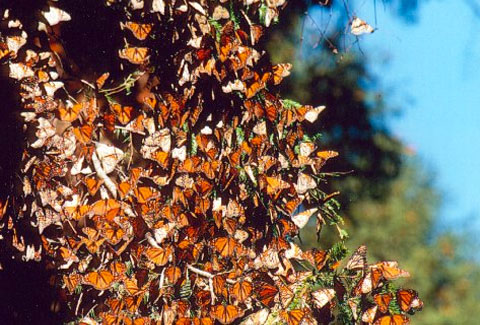MIGRATIONS EAST & WEST

Migration East
Millions of monarchs east of the Rocky Mountains make their 3,000 mile migration from Canada to Mexico every year. This sanctuary was discovered in 1975 by Frederick Urquhart, a zoologist. Fred and his wife, Norah Roden Urquhart, along with co-workers Catalina Trails and Ken Brugger, discovered where the butterflies spend their hidden overwintering months in Mexico.
What an exciting discovery for the World to see! On an eventful day in 1975, Catalina yelled… “I see them! I see them!” Soon the rest of the world would learn about the monarchs’ migration site in Mexico!
Check out this educational site from JOURNEY NORTH to learn more about the overwintering site in Mexico…Check out this educational site from JOURNEY NORTH to learn more about the overwintering site in Mexico…Learner.org

Migration West
The Monarch Grove Sanctuary in Pacific Grove, California celebrates this over-wintering event from October through February. They have been called BUTTERFLY TOWN USA, hosting many events each year for families and visitors!
Monarchs over-wintering in The Butterfly Grove at Pismo Beach are a site to behold! You can watch them cluster together!.They snuggle closely with theirs wings pointed downward-extended over each other like “shingles on a roof” ~ insuring more protection from the cold. Check out this link for monarch watching…www.monarchbutterfly.org.

The Discovery That Made History!
Across the USA monarchs soar and glide in the warm sunshine from March through October (depending where they are born), but what happens in the fall when the brisk cold winds set in and winter looms in the air?
Monarchs cannot survive cold winter temperatures of the northern states. So what does a monarch do to keep warm? It MIGRATES south and HIBERNATES! This means that it rests, with a very slow heart rate, just like bears in their hibernation caves. Monarchs east of the Rockies migrate 2500 miles to the Oyamel fir trees of Mexico. Monarchs west of the Rockies migrate to southern California to the eucalyptus trees of Pacific Grove and surrounding areas.
The monarch’s flight to Mexico has been compared to the migration habits of birds flying south for the winter. It is the only insect that can fly 2,500 miles to a warmer climate. Their unique wing structure and yearly life cycle makes it possible for the fall generation monarchs to travel thousands of miles (on those amazing little wings) to the warm nesting grounds of Mexico and southern California.
The monarch’s amazing migration to Mexico is a scientific wonder and mystery to all who have studied and enjoyed its extraordinary story and discovery.

It all began in the early 1950s with Dr. Fred A. Urquhart and his thirst for knowledge and dedicated passion for the monarch butterfly. Dr. Urquhart developed a unique tagging system for the monarch’s wing.
He wrote an article called “Marked Monarchs” in 1952. This article caught the attention of twelve people who volunteered and assisted in the creation of the Insect Migration Association. This wonderful organization has evolved into the well-known, educational organization we know today – MONARCH WATCH.
The Discovery
In 1975, while working for monarch specialist Dr. Fred Urquhart and his wife, Nora, a Mexican scientist named Ken Brugger and his wife, Catalina, discovered over one million monarchs basking in the sun in the oyamel trees of Mexico. For over two years they had searched for this secret, overwintering site and on one momentous day, their discovery made history!
The next year, in August of 1976, the couple traveled with Dr. Urquhart and the photographer from National Geographic Magazine into the mountainous area.
“Unbelievable! What glorious incredible sight!” was written by Fr. Fred A Urquhart, Ph.D. in August 1976. It happened THERE – five minutes upon entering the secluded sanctuary, a branch laden with hundreds of monarchs broke and fell to the ground.
In a desperate attempt to assist, Dr. Urquhart discovered a TAGGED monarch ~ a tagged monarch from Minnesota! What were the chances, the coincidence of this happening, in the midst of all these millions of monarchs? This discovery was the PROOF! This monarch had traveled the unbelievable 2000-3000 mile journey, tagged by Jim Gilbert who lived in Chaska, Minnesota.
According to the magazine article, Mr. Gilbert later shared a photograph of the original field of goldenrod where the butterfly was tagged. It was as if the beautiful butterfly that glides and soars over vast areas of the United States, had somehow “come home” in a symbolic way to its place of origin.

I do not know of any species of insect that has aroused a greater interest among the populace in many parts of the world than the monarch butterfly. One of the great pleasures Norah and I have had in our studies of the monarchs has been receiving letters from children and adults alike, expressing their delight at being introduced to the study of nature through our program of monarch butterfly tagging and research. Studying monarch butterflies has been a source of great happiness for us.
– Fred Urquhart, 1987

Fred and Norah Urquhart founded the Insect Migration Association (known today as Monarch Watch), enlisting thousands of volunteers across North America to tag hundreds of thousands of butterflies in order to track their migration route. In 1975, this association ultimately helped Dr. Urquhart determine where millions of butterflies migrated – the remote Transvolcanic Belt of central Mexico.
WEBSITE MonarchWatch.org
LIFE HISTORY Dr. Urquhart and his wife Norah.





















